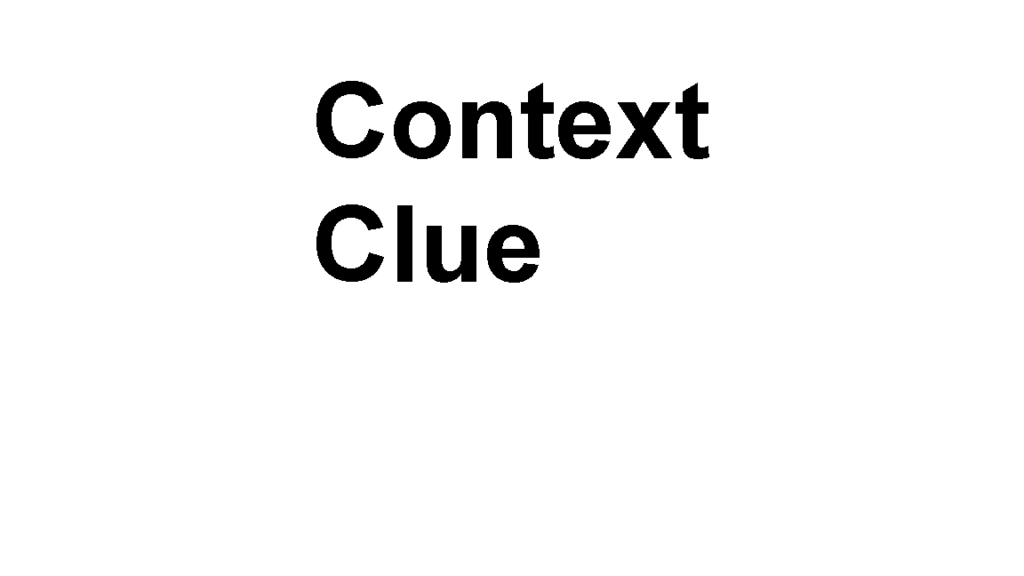What is context clue
Context clues are pieces of information within a text that help readers understand the meaning of unfamiliar words or phrases. They can be found in the surrounding sentences or paragraphs and provide hints or clues about the intended meaning.
There are different types of context clues that can be used to determine the meaning of a word:
Definition: The word is directly defined within the sentence or nearby text.
Synonym: A word with a similar meaning is used in the sentence or nearby text.
Antonym: A word with the opposite meaning is used in the sentence or nearby text.
Example: Examples or illustrations are given to explain the meaning of the word.
Inference: Readers can make an educated guess about the word’s meaning based on the overall context of the text.
By analyzing the context clues, readers can make informed guesses about the meaning of unfamiliar words and improve their comprehension of the text.
Context clues are an essential tool for readers to decipher the meaning of unfamiliar words or phrases. Here are some additional details about context clues:
Definition:
Sometimes, the definition of a word is provided directly within the sentence or in close proximity to the word itself. This can be in the form of a straightforward explanation or a synonymous phrase.
Example: “The word ‘meticulous’ means extremely careful or precise. The painter was meticulous in his attention to detail, ensuring every brushstroke was perfect.”
Synonym:
A context clue may include a synonym, which is a word with a similar meaning to the unfamiliar word. By identifying the synonym, readers can infer the intended meaning.
Example: “The dog was ravenous, devouring its food in seconds. ‘Ravenous’ here means extremely hungry or voracious.”
Antonym:
An antonym, which is a word with the opposite meaning, can also provide context clues. By contrasting the unfamiliar word with its antonym, readers can deduce the intended meaning.
Example: “Despite the scorching heat, she wore a thick coat, which was peculiar. ‘Peculiar’ in this context means unusual or strange.”
Example:
Sometimes, context clues include examples or illustrations that help clarify the meaning of the unfamiliar word. These examples provide specific instances that demonstrate the word’s usage.
Example: “The athlete’s agility allowed her to swiftly navigate through the obstacle course, effortlessly leaping over hurdles and zigzagging between cones. ‘Agility’ refers to the ability to move quickly and gracefully.”
Inference:
In some cases, readers need to make an educated guess about the meaning of an unfamiliar word based on the broader context of the text. By considering the surrounding information and the overall message, readers can infer the intended meaning.
Example: “The detective carefully examined the crime scene, meticulously analyzing every piece of evidence. From the context, we can infer that ‘meticulously’ means doing something with great attention to detail and thoroughness.”
By actively using context clues, readers can enhance their vocabulary, comprehension, and overall understanding of the text they are reading.
When to use context clue?
Multiple Context Clues: Often, a single sentence or passage may contain multiple context clues that collectively contribute to understanding the meaning of an unfamiliar word. It’s important to consider all the available clues to gain a comprehensive understanding.
Word Relationships: Pay attention to the relationships between words within the context. Words that are related in meaning or function can provide valuable clues. For example, if the sentence mentions “tools” and “hammer,” an unfamiliar word like “wrench” can be inferred to be another type of tool.
Word Forms: Understanding different forms of words can aid in deciphering their meanings. For example, prefixes, suffixes, or root words can provide clues. If you encounter an unfamiliar word like “unhappiness,” the prefix “un-” suggests a negation, and “happiness” indicates the base meaning.
Domain-Specific Context: In specialized texts or subject-specific content, context clues can be derived from the topic or subject matter itself. Familiarity with the domain can assist in understanding technical or specialized vocabulary.
Contextual Constraints: Sometimes, the context of a sentence or paragraph places constraints on the potential meaning of an unfamiliar word. These constraints help narrow down the possibilities and increase the accuracy of interpretation.
Revisiting Context: If you encounter a challenging word, it can be helpful to reread the sentence or preceding text to reinforce your understanding of the context. Increased familiarity with the overall context often leads to improved comprehension.
Diverse Texts: Reading a wide range of texts, including fiction, non-fiction, articles, and literature from various fields, exposes you to different contexts and vocabulary. This exposure enhances your ability to identify and interpret context clues effectively.
Remember that context clues are not foolproof and may sometimes lead to partial or approximate understanding. It’s essential to verify the inferred meaning by consulting dictionaries or seeking clarifications to ensure accuracy.
Developing strong contextual analysis skills can significantly enhance reading comprehension, expand vocabulary, and foster a deeper understanding of written material across various subjects and genres.
examples of context clues from different types of texts:
Fiction:
Sentence: “The protagonist’s heart raced as she entered the dark, eerie mansion, feeling a sense of foreboding.”
Context Clue: The word “foreboding” suggests a feeling of impending danger or something negative. The description of the dark and eerie mansion contributes to the overall context and reinforces the sense of unease.
Non-fiction:
Sentence: “Scientists have discovered a new species of marine life in the depths of the ocean, which they named ‘abyssal anglerfish.'”
Context Clue: The words “new species” and “marine life” indicate that “abyssal anglerfish” is likely the name of a type of fish found in the ocean. The context of scientific discovery and the mention of its classification as a species provide clues about its meaning.
Academic Text:
Sentence: “The study conducted by Smith et al. (2020) revealed a strong correlation between regular exercise and improved cognitive function.”
Context Clue: The phrase “correlation between regular exercise and improved cognitive function” suggests that “cognitive function” refers to mental abilities or processes. The mention of the study conducted by Smith et al. and its focus on exercise and cognitive function provide the necessary context.
Historical Text:
Sentence: “The Emancipation Proclamation, issued by President Abraham Lincoln in 1863, declared the freedom of slaves in Confederate states.”
Context Clue: The phrase “declared the freedom of slaves” indicates that “Emancipation Proclamation” refers to a significant document or proclamation related to the abolition of slavery. The historical context of President Lincoln and the mention of slaves and Confederate states provide contextual clues.
Technical Text:
Sentence: “The software engineer used a debugging tool to identify and fix the error in the program code.”
Context Clue: The phrase “debugging tool” implies a software or tool used to locate and resolve errors in program code. The mention of the software engineer and the process of identifying and fixing errors provide context clues specific to the field of software development.
In each example, the context clues help readers infer the meaning of unfamiliar words or phrases by considering the surrounding information and the nature of the text. These clues can be found in various forms, such as definitions, associations, subject-specific terms, or historical references, depending on the type of text being analyzed.
examples of context clues from different genres of literature:
Mystery:
Sentence: “The detective examined the crime scene meticulously, carefully collecting fingerprints and photographing the evidence.”
Context Clue: The word “meticulously” suggests that the detective is paying close attention to detail. The mention of collecting fingerprints and photographing evidence contributes to the context of a crime investigation, indicating that “meticulously” means doing something with great attention and thoroughness.
Fantasy:
Sentence: “The young wizard waved his wand and uttered the incantation, causing sparks to fly and a magical portal to appear.”
Context Clue: The mention of a “wizard,” “wand,” “incantation,” and “magical portal” suggests that the text is set in a fantasy world where magic exists. These elements provide context clues for understanding the specialized vocabulary associated with the fantasy genre.
Romance:
Sentence: “As their eyes met across the crowded room, she felt a flutter in her heart and a blush creeping onto her cheeks.”
Context Clue: The phrases “eyes met,” “flutter in her heart,” and “blush creeping onto her cheeks” indicate a romantic atmosphere. The context of a crowded room and the emotional response of the characters contribute to understanding the romantic context and the feelings involved.
Science Fiction:
Sentence: “The astronaut donned the advanced exosuit, which provided enhanced strength and protection in the hostile alien environment.”
Context Clue: The term “exosuit” suggests a specialized suit worn by the astronaut. The mention of enhanced strength, protection, and a hostile alien environment indicates the science fiction genre. The futuristic setting and the technology involved provide clues to understanding the context.
Historical Fiction:
Sentence: “In the midst of the Civil War, the young protagonist embarked on a perilous journey to reunite with her family, evading Confederate soldiers along the way.”
Context Clue: The mention of the Civil War and “Confederate soldiers” indicates a historical setting. The protagonist’s journey and the reference to the challenges faced provide context clues specific to the historical fiction genre.
In each example, the context clues help readers situate the text within a particular genre and understand the meaning of genre-specific terms or concepts. By considering the elements, settings, and situations described, readers can make informed inferences and engage with the literary context effectively.
examples of context clues from classic literature works:
“Pride and Prejudice” by Jane Austen:
Sentence: “Mr. Darcy’s countenance was grave and aloof, his eyes coldly surveying the room.”
Context Clue: The words “grave,” “aloof,” and “coldly” suggest that Mr. Darcy’s demeanor is distant and unfriendly. The description of his countenance and the way he surveys the room provide context clues about his character and attitude.
“To Kill a Mockingbird” by Harper Lee:
Sentence: “Atticus Finch, a respected lawyer, defended Tom Robinson with unwavering conviction, despite the prejudice of the townspeople.”
Context Clue: The phrases “respected lawyer,” “defended,” “unwavering conviction,” and “prejudice of the townspeople” offer context clues. They indicate that Atticus Finch is an advocate for justice, standing up for Tom Robinson despite the opposition he faces from the townspeople.
“Moby-Dick” by Herman Melville:
Sentence: “Captain Ahab, with his body scarred and his leg replaced by a prosthetic, sought vengeance against the white whale that had taken his limb.”
Context Clue: The description of Captain Ahab’s scarred body and his prosthetic leg provides context clues about his past and the motivations driving his desire for vengeance. These details contribute to the understanding of his character and the central conflict in the novel.
“Jane Eyre” by Charlotte Brontë:
Sentence: “Jane’s heart pounded as she stood at the threshold of Thornfield Hall, her new home, uncertain of what awaited her within its walls.”
Context Clue: The mention of Jane’s heart pounding and her uncertainty about her new home, Thornfield Hall, indicates a sense of anticipation, tension, and the unknown. These details contribute to the atmosphere and foreshadow potential challenges or mysteries within the story.
“The Great Gatsby” by F. Scott Fitzgerald:
Sentence: “Gatsby’s opulent mansion stood as a beacon of wealth and excess, its extravagant parties drawing crowds eager to partake in the glamour and revelry.”
Context Clue: The words “opulent,” “wealth,” “excess,” “extravagant parties,” and “glamour and revelry” provide context clues about the setting and Gatsby’s lifestyle. These details contribute to the understanding of the decadence and allure surrounding the character.
In each example, the context clues help readers grasp important details about the characters, settings, and themes within the classic literature works. These clues provide insights into the author’s intentions and enrich the reading experience.
Find us on Facebook
All you need to study in English

